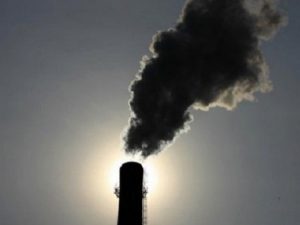Carbon credits are not successful in bringing in revenue for Pakistan.
It is possible to acquire credits through activities such as reforestation, green cover, solar power, and wind power.

ISLAMABAD: Carbon trading provides developing nations with cutting-edge and innovative trade and commercial options so they may profit financially from reducing greenhouse gas (GHG) emissions.
A carbon credit, also known as a carbon offset, is a payment for the greenhouse gas (GHG) emissions that have been decreased or eliminated from the atmosphere as a result of emission-reducing actions taken by a government, industry, or private person to make up for emissions produced elsewhere.
At the Glasgow COP26 climate change summit in November 2021, it was decided to establish a global market for trading carbon credit offsets. Any action that can prove the control, reduction, avoidance, or destruction of one metric ton of GHG will therefore result in the creation of one carbon credit.
Avoiding natural loss due to deforestation or degradation, nature-based sequestration such as reforestation, reducing emissions (methane) from animal dung/landfills, and removing carbon dioxide from the atmosphere and or its destruction using various techniques are the main emission-control tools and techniques eligible for carbon credits.
Either in the voluntary markets, which operate outside of the compliance markets and allow businesses and individuals to buy carbon offsets, or in the compliance markets, which are established and governed by national, regional, or international carbon-reduction regimes, carbon credits can be earned.
Carbon credits are bought on the voluntary carbon market, typically by organizations, for voluntary usage. Markets for voluntary carbon are expanding, in part due to demand from companies trying to reduce their emissions.
International, regional, and subnational carbon-reduction programs, including the California Carbon Market, the European Union Emissions Trading System (EU-ETS), and the Clean Development Mechanism (CDM) under the Kyoto Protocol, govern the carbon market.
From 2021 to 2025, Pakistan’s cooperation with China’s carbon emission trading system presents enormous prospects. Countries can trade in the global carbon credit market under the International Emissions Trading (IET) system to make up for any shortage in the designated number of units.
In accordance with Annex B of the Kyoto Protocol, nations that have excess units can sell them to nations who are exceeding their emission objectives. Land can store carbon, therefore farmers and other landowners can trade carbon credits. You must have land maps that show your ownership of the property, as well as the legal description of the property, in order to enroll.
On the voluntary carbon markets, landowners can sell carbon offsets. These buyers of carbon credits do so as investments or because their companies have internal standards for reducing their carbon footprint.
Anyone who owns and maintains forested land may be allowed to market carbon credits produced by management practices on their property. However, before pursuing specific eligibility requirements, there are a few issues to think about.
Governments that have excess units may sell them to nations that are not meeting their Kyoto Protocol emission targets. The Kyoto Protocol’s Article 17 defines the idea of trading carbon credits.
Presently, countries in Europe are the biggest buyers of carbon credits, while India and China are the biggest sellers. A project will be qualified to receive carbon credits if it can consistently and quantitatively produce fewer GHG than the current alternative.
For instance, replacing a coal plant with a solar farm after five years would prevent 25 years’ worth of emissions from coal. Personal carbon credits are a voluntary way for people to directly cut down on their energy use and the associated GHG emissions.
Lower utility bills and the value of the generated personal carbon credits serve as rewards for successful individual reductions.
Plantations, reforestation, different types of greenery, solar and wind energy, reducing methane emissions from livestock and paddy fields, and other GHG emission-controlling activities can all help Pakistan earn carbon credits.
The government of Sindh has already received the first tranche of $14.75 million in 2022, which may increase to $24-25 million in the next five years, and this increase will continue for the 60-year commitment period. Pakistan has successfully completed a project that earned carbon credits.
There is therefore a lot of room and potential for obtaining carbon credits on a larger scale, and Pakistan is already benefiting from them thanks to a forestry project.
The process of replicating this outstanding success story of obtaining carbon credits to other forestry and GHG-controlling initiatives is currently being hindered by a lack of institutional structures, commitments, and capacity.
When it comes to the ownership of carbon stock, which is mostly controlled by the provinces as a result of the devolution brought on by the 18th Amendment, Pakistan lacks not just the necessary competence but also clarity and promises.
The Ministry of Climate Change serves as the focal point for the UNFCCC and other international agreements such as the methane pledge and the carbon trading scheme, but Pakistan’s ability to make money from the sale of its carbon credits is in jeopardy due to the absence of a clear policy and mandate.
The government is forced to focus solely on creating a registry, putting an end to concurrent efforts to pursue financially lucrative solar, hydel, and methane-pledge projects.
The ministry’s capacity to quickly acquire carbon credits is being jeopardized by the generalist decisions, also known as taboos, because the ministry lacks the technical skills in this highly creative sector.
With a proposal submission rates of only 0.6% and earnings of only 0.4% of the dollars compared to the Asia-Pacific, CDM, which ran from 2005 until recently (existed only for a few years in project mode), failed to generate any revenue for us (India and China). We will again be missing a much greater chance if business as usual continues.
Pakistan may simply make money, just like the government of Sindh did by selling carbon credits from mangroves. Ironically, there is confusion about voluntary markets as well as capacity.
The hallways of the focal ministry are completely silent when it comes to directing, instructing, and raising awareness about this burgeoning industry. Pakistan is implementing solarization to address its electricity shortage, but the ministry is mute on the carbon credits that solar energy generates at the individual and corporate levels.
Also, all of the green industries like hydro, biogas, plantations, and others can bring in money quickly if the main ministry is aggressive and eager to promote such tactical initiatives.









































